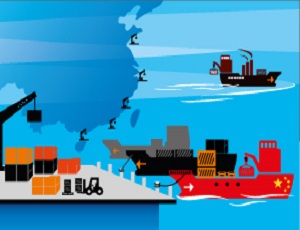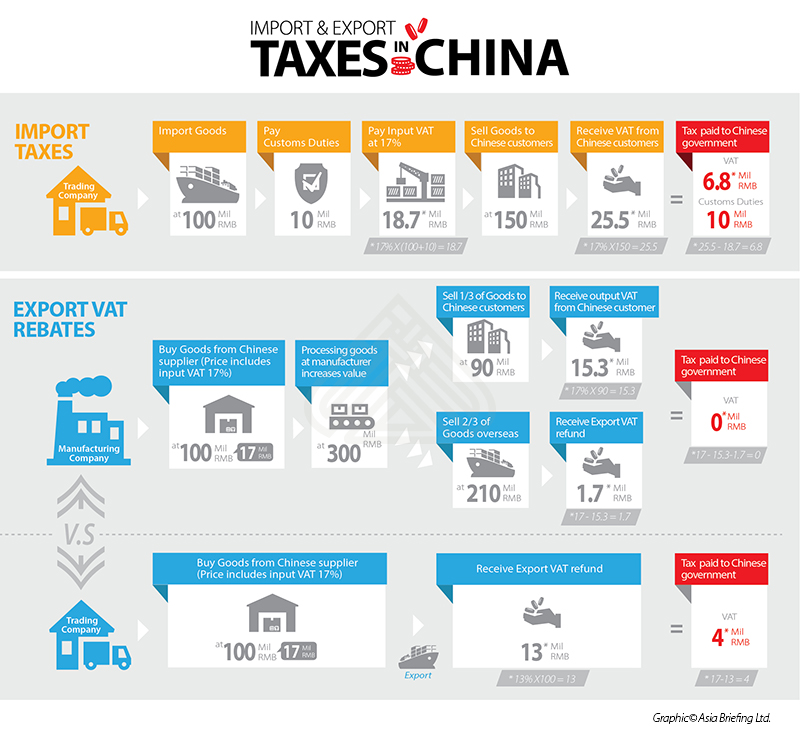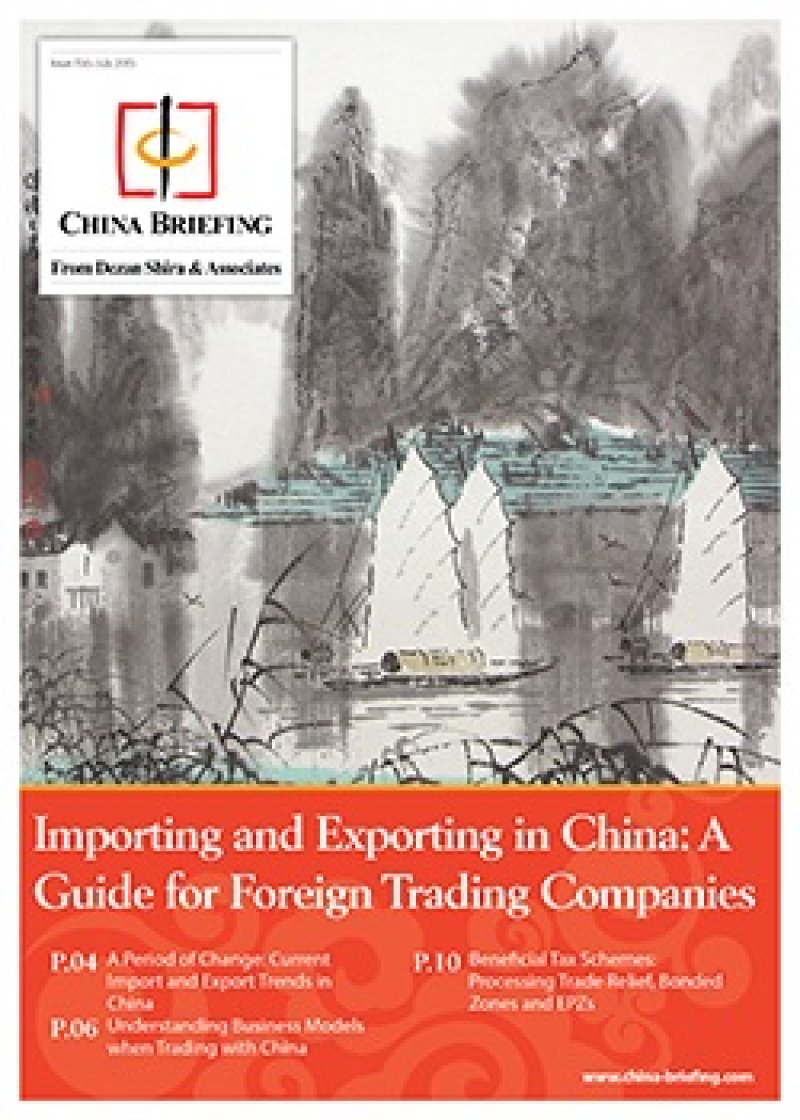Understanding Business Models When Trading with China
 By Dezan Shira & Associates
By Dezan Shira & Associates
Editor: Steven Elsinga and Qian Zhou
There are several different approaches that foreign companies can take when importing from or exporting to China. Not all of these require the foreign investor to set up an entity in China. Depending on one’s situation, certain approaches work better than others. In our 2013 magazine Sourcing from China, we discuss the different models available when importing from China. This section will discuss some of the options a company that exports products to China might want to use.
Agents and Distributors
Small to medium-sized companies often rely on either agents or distributors when selling their products in China. While in both cases, the foreign company itself does not need to have a presence in China, there are differences between the two approaches.
An agent typically finds customers in China for the foreign company in return for a commission on sales. It does not own the goods. A distributor, however, purchases the goods from the foreign supplier and sells them in China on its own account.
Having a distributor means that the foreign company can be less involved in the process and bear less risk, but at the same time, it has to shed some control as well, such as in the marketing, branding and pricing of the products.
Setting up a Company in China
There are various reasons why a foreign company will want to set up a subsidiary in China when exporting its goods to the country. Without having an entity in China, the foreign company will be unable to hire staff. It will also be unable to issue VAT invoices to Chinese customers, or directly take payment in and convert RMB. With the entity selling the products under its own name, it can set the price itself. If the foreign company has personnel on the ground in China, it can establish firmer control over matters such as intellectual property protection, communication between customers and the foreign headquarters, logistics and quality control.
This would, however, require a far larger upfront investment, and would be more costly and time-consuming than going through an agent or distributor. Setting up a company in China takes several months and results in a higher tax burden. Foreign firms additionally need to consider how to repatriate profit and stay in compliance with China’s laws and regulations.
![]() RELATED: Business Advisory Services from Dezan Shira & Associates
RELATED: Business Advisory Services from Dezan Shira & Associates
Licenses Required for Import and Export
A number of licenses are required when setting up a company for import and export. Some of these need to be applied for during the incorporation process. The trading of certain goods requires a license, such as food, drugs or medical devices. When this type of business is included in the company’s business scope and business license, the investor will often need to get the product specific license first, before being granted the business license.
After the company is set up, it needs to apply for an import/export license. The procedure is as follows:
- Apply for Foreign Trade Operator Filing with the local branch of the Ministry of Commerce;
- Register with customs;
- Registration and record-filing with the China Inspection and Quarantine Bureau;
- Register with e-port;
- Foreign currency exchange registration with the local branch of the State Administration of Foreign Exchange.
If the company is trading goods that are subject to a quota – as mentioned in the first article – it will need to apply for a separate license for each individual batch of goods as well.
Tax Considerations of Importing and Exporting
When importing goods into China, companies face three types of taxes. These are value-added tax (VAT), consumption tax and customs duties.
Consumption tax is imposed on companies that manufacture, import, sell or process under consignment the following goods:
- Products whose overconsumption is harmful to health, social order and the environment, e.g. tobacco, alcohol, firecrackers and fireworks;
- Luxury goods and non-necessities, such as jewelry and cosmetics;
- High-energy consumption products, such as cars and motorcycles;
- Non-renewable and non-replaceable petroleum products, such as gasoline and diesel oil; and
- Motor vehicle tires.
Import duties are levied on the price the importer paid for the goods, including insurance and transport. The tariff rate for the goods differs per product, based on the product’s HS code. The HS code can be looked up online, and roughly corresponds to the ones used in the US and Europe.
Export duties are calculated the same way, but are only levied on a small number of raw materials and semi-manufactured goods.
Import VAT is calculated over the price of the imported goods, including customs duties and (if applicable) consumption tax. The rate is usually 17 percent. A small selection of goods is subject to a lower rate of 13 percent, including water, gas, edible oils, agricultural products, feed and fertilizers.
Import VAT = (price of goods + customs duty + consumption tax) x 17% (or 13%)
Upon export, the company receives a VAT rebate for the goods exported. There are two types of Export VAT rebates, one for manufacturing companies and one for companies that do not engage in manufacturing (i.e. companies that do not have manufacturing in their business license).
Trading companies and other non-manufacturing enterprises follow the Exemption – Refund (ER) system. Exemption stands for the fact that no VAT is withheld by the trading company when selling goods to an overseas party. The exporter is therefore unable to offset its input VAT on its purchases with output VAT on its overseas sales. Instead, the Chinese government refunds some of the VAT the company would normally have been able to collect – the Refund part of the system.
![]() RELATED: China’s Import and Export Licensing Framework
RELATED: China’s Import and Export Licensing Framework
The trading company however would not always get a full refund. Instead, the Chinese government gives a refund at a percentage of the goods. If this percentage is less than the percentage of input VAT paid (as mentioned, usually 17%) the company ends up with an added tax burden.
The refund rate depends on the type of good being exported, i.e. its HS code. There are six different export VAT refund rates: 5%, 9%, 11%, 13%, 16% and 17%. Especially goods that the central government wants to discourage companies from producing are given lower rebate rates. These include industries that deplete natural resources or pollute the environment.

Therefore, selling goods overseas often means a company gets less of its VAT refunded than it would if the goods were sold in China.
Manufacturing enterprises follow the Exemption – Credit – Refund (ECR) system. As with the ER system for trading companies, when a manufacturing company exports goods, it cannot withhold output VAT from its overseas customers (Exemption). The manufacturing company may then use the output VAT it received from domestic customers to offset its input VAT. This is what the Credit part of the system refers to. If any input VAT remains (as is the case in our example in the infographic above), the government will refund that remaining VAT. This tends to occur when the value of exports is high relative to domestic sales.
However, it is also possible that the output VAT on domestic sales exceeds the input VAT. In that case, the manufacturing company is left with excess output VAT it received from domestic customers.
The manufacturing company will then have to pay the excess output to the government. This may happen when the manufacturing company sells a large amount of its goods in China, with a high added value relative to the price of the raw materials it purchased. In that case the input VAT it paid would be very low, but the output VAT it received from customers would be very high.
 This article is an excerpt from the July issue of China Briefing Magazine, titled “Importing and Exporting in China: a Guide for Trading Companies.” In this issue of China Briefing, we discuss the latest import and export trends in China, and analyze the ways in which a foreign company in China can properly prepare for the import/export process. With import taxes and duties adding a significant cost burden, we explain how this system works in China, and highlight some of the tax incentives that the Chinese government has put in place to help stimulate trade. This article is an excerpt from the July issue of China Briefing Magazine, titled “Importing and Exporting in China: a Guide for Trading Companies.” In this issue of China Briefing, we discuss the latest import and export trends in China, and analyze the ways in which a foreign company in China can properly prepare for the import/export process. With import taxes and duties adding a significant cost burden, we explain how this system works in China, and highlight some of the tax incentives that the Chinese government has put in place to help stimulate trade. |
![]()
Using China’s Free Trade & Double Tax Agreements
In this issue of China Briefing, we examine the role of Free Trade Agreements and the various regional blocs that China is either a member of or considering becoming so, as well as how these can be of significance to your China business. We also examine the role of Double Tax Treaties, provide a list of active agreements, and explain how to obtain the tax minimization benefits on offer.
 Employing Foreign Nationals in China
Employing Foreign Nationals in China
In this issue of China Briefing, we have set out to produce a guide to employing foreign nationals in China, from the initial step of applying for work visas, to more advanced subjects such as determining IIT liability and optimizing employee income packages for tax efficiency. Lastly, recognizing that few foreigners immigrate to China on a permanent basis, we provide an overview of methods for remitting RMB abroad.
 Double Taxation Avoidance in China: A Business Intelligence Primer
Double Taxation Avoidance in China: A Business Intelligence Primer
In our twenty-two years of experience in facilitating foreign investment into Asia, Dezan Shira & Associates has witnessed first-hand the development of China’s double taxation avoidance mechanism and established an extensive library of resources for helping foreign investors obtain DTA benefits. In this issue of China Briefing Magazine, we are proud to present the distillation of this knowledge in the form of a business intelligence primer to DTAs in China.
- Previous Article China Regulatory Brief: Zero VAT Rate for Exporting Services, New Seed Law Released
- Next Article China Regulatory Brief: Simplified Registration Procedure for Foreign Investors in China’s Real Estate Market










